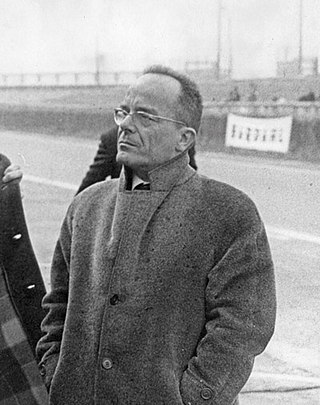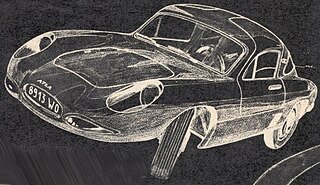
Deutsch-Bonnet (DB), is a brand of sports cars created in 1937 by Charles Deutsch and René Bonnet and disappeared in 1962.

Charles Deutsch (1911–1980) was a French aerodynamics engineer and automobile maker, founder of the brand "DB" with René Bonnet, and later of the "CD".
Robert Choulet is a French aerodynamics engineer influential in race car dynamics.

Facel S.A. was a French manufacturer of pressed steel automobile components, later complete automobiles of their own design.

Chappe et Gessalin is the short-form of the name of French coachbuilder "Carrosserie Chappe Frères et Gessalin". The company built automobile bodies and did contract assembly for other automobile manufacturers. It was also the parent of Automobiles CG, a French automobile maker founded in 1966 which built and sold complete cars under its own name.

Panhard was a French motor vehicle manufacturer that began as one of the first makers of automobiles. It was a manufacturer of light tactical and military vehicles. Its final incarnation, now owned by Renault Trucks Defense, was formed by the acquisition of Panhard by Auverland in 2005, and then by Renault in 2012. In 2018 Renault Trucks Defense, ACMAT and Panhard combined under a single brand, Arquus.
Automobiles René Bonnet was a French automobile maker.

The Atla is a French automobile that was manufactured from 1957 to 1959 in the commune of Garches in the western suburbs of Paris.

The Renault Caravelle is a sports car manufactured and marketed by Renault for model years 1958–1968 in a single generation — as a rear-engine, rear-drive open two/four-seater designed by Pietro Frua of Carrozzeria Ghia, using the floorpan and engine of the Renault Dauphine.
Marie André Marcel Riffard was a French aeronautical engineer. He designed fighter aircraft and air racers, as well as airplanes for postal delivery and medical transport. He also designed racing cars and land-speed record cars for Panhard and Renault. Riffard has been called the "Father of modern aviation".

Carrosserie Pourtout was a French coachbuilding company. Founded by Marcel Pourtout in 1925, the firm is best known for its work in the decades prior to World War II, when it created distinctive and prestigious bodies for cars from numerous European manufacturers. Pre-war Pourtout bodies were mainly one-off, bespoke creations, typically aerodynamic and sporting in character. Together with chief coach designer and stylist Georges Paulin from 1933 to 1938, Pourtout pioneered the Paulin invented 'Eclipse' retractable hardtop system on four models of Peugeot, several Lancia Belna's and other car makes.
Among the company's customers was Georges Clemenceau, the physician and journalist who served as the prime minister of France from 1906 to 1909 and 1917 to 1920.

Marathon was a French automobile manufacturer established by a group of engineers under the leadership of a rally enthusiast called Bernard Denis. Prototypes for a lightweight sports coupé were presented at various motor shows starting with the 1951 Frankfurt Motor Show and the cars were produced between 1953 and 1955.

The HBR 5 model (1954–1959) was Deutsch and Bonnet's (DB) most successful project to date, with several hundred of the cars produced until 1959. Another small series of lowered and lightened cars called "Super Rallye" occurred in 1960 and 1961. Around 660 of the Mille Miles, Coach, and HBR 4/5s were built in total. Other sources account for 950 DB coupés, of which nearly all would be HBRs and their Frua-designed predecessors.

The DB Le Mans is a fibreglass-bodied two-door sports car with front-wheel drive, built in France from 1959 until 1964. Originally equipped with Panhard two-cylinder boxers, the cars built by René Bonnet had Renault four-cylinder engines. The car, with pronounced tailfins and more comfort than previous efforts by DB, was aimed squarely at the US market.
The Paris–Marseille–Paris race was the first competitive 'city to city' motor race originating in Paris, where the first car across the line was the winner, prior events having selected the winner by various forms of classification and judging. The race was won by Émile Mayade who completed the ten-day, 1,710 km, event over unsurfaced roads in 67 hours driving a Panhard et Levassor.
The SOciété des Véhicules André Morin (SOVAM) is a French company that specializes in mechanized handling equipment for airports. In the mid-to-late 1960s they also operated an automobile manufacturing division that enjoyed a modicum of success but that was never profitable.
Jacques Durand was a French engineer, model builder and automobile designer. He is primarily known for designing several sports cars, which were built in small volumes in France beginning in the 1950s and continuing into the 1990s.

The Panhard CD is a car designed by Charles Deutsch and built by Panhard from 1963 to 1965. The CD was named for Deutsch and is considered a continuation of the line of Panhard-powered vehicles built by Deutsch-Bonnet. The car was the production version of the CD Dyna that raced at Le Mans in June 1962.
Louis Bionier (1898–1973) was a French automotive engineer. He is best known as head of chassis development and chief stylist for carbuilder Panhard. He was also involved in the design of some of Panhard's military vehicles.
Pichon-Parat was a French carrosserie based in the commune of Sens, in the department of Yonne. Established in 1952, it was known for producing custom cabriolet, coupé, estate car, and shooting brake conversions of established models from major automakers, and for building their own distinctive sporting models with completely original bodywork.












